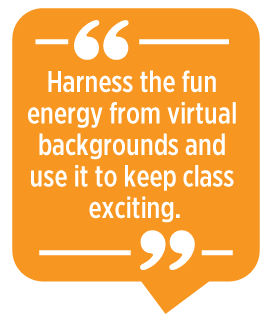|
 Over the past few weeks, I have watched my colleagues demonstrate what adaptability and resilience means with regards to online teaching. I’m amazed at how quickly we have all moved our classes online, with great results. Now that we have our content figured out, let’s turn our focus to the learner experience. Here are some ideas for embracing the features found in most classroom platforms to enhance your classroom management for language learning online.
Over the past few weeks, I have watched my colleagues demonstrate what adaptability and resilience means with regards to online teaching. I’m amazed at how quickly we have all moved our classes online, with great results. Now that we have our content figured out, let’s turn our focus to the learner experience. Here are some ideas for embracing the features found in most classroom platforms to enhance your classroom management for language learning online.
1. Create a Routine for Starting the Class
We know that a routine is important for classroom
management. My in-person classes always started with a warmer—an easy game to
allow students to feel comfortable and relaxed at the start of class. Online,
there seems to be a lull as we wait for all the students to appear. We watch
names pop up with cameras and microphones turned off. I see it as the digital
equivalent of the student who would stand outside the classroom to be able to
walk in with their friends. Now they are forced to risk being the first student
in class and have to talk to the teacher (gasp!).
To help
students feel comfortable entering the “room” alone, I put a small assignment
in the chat box or on the “whiteboard” so that students know immediately what
they need to look at. Some days, it’s a question that we will be talking about,
other days it simply says “We’ll go over homework first—make sure you have it
finished.” I find that students don’t log in to class late because they are no
longer afraid of being caught alone with me! They also know what to expect at
the start of every class. It takes just a minute to create the virtual warmer
for the day, and the effects can be felt immediately.
2. Call on Students by
Name
In person,
many teachers ask a question and look around for a volunteer to provide a
response. The live classroom allows teachers to see slight shifts in body language
that signal a student is ready to speak. Getting to know our learners and their
signals is part of the fun of teaching. Online, however, we do not have access
to the same rich context that provides these clues. When a question is posed
that is met with silence, the pace of the class drops, and students start
looking bored.

I recommend
calling out names. Call them often. Call them loudly. At first, it may feel
very uncomfortable for students who are not used to this style of class, but I
promise, in time, it will help not only diversify the participation in class,
but also the pace of the lesson. Don’t be afraid to choose a student. They will
answer! If this is very different from the style you are comfortable with,
agree with your class on a word to use to request a pass. If you call on a
student who is unprepared to reply, they can call out “skip,” and trust that
you will move on. However, this is also a good way to teach that making
mistakes is expected and a natural part of language learning.
3. Use the Tools
Available and Make Sure Students Know How to Use Them,
Too
No matter
which learning management system or online platform you are using, now is the
time to master it. Learn about all the features that you can exploit for your
classroom management. Here are some of my favorite features to use:
Mute
Mute is one
of my favorite functions to use in unexpected ways. On most platforms, the
moderator or presenter has the ability to mute or unmute participants. This
function can be used to play quick-paced games. Picture a typical vocabulary
review game where one team gives a clue and another has to guess the answer.
Telling a student that they have 5 seconds to answer and then muting them to
keep the time is super fun and adds a level of excitement that is hard to
create online. Some platforms allow the role of moderator to be transferred to
anyone logged in—in that case, a student team captain can call on and mute
their classmates to create that competitive vibe that is often missing online.
Raise
Hands
This
function is available on most platforms in some form. It’s really useful to
avoid the strange lapses in activity that result in a student trying to ask a
question and forgetting they are on mute or having a moment of slow Internet
connectivity. Create an online class culture where students use the “hand
raised” signal when they have a question, a contribution to the conversation,
or an answer to keep the lesson moving.
 Feedback Buttons Feedback Buttons
These
buttons take different forms on different platforms. On Zoom, participants have
access to buttons like thumbs up, thumbs down, and request to slow down, among
others. Blackboard Collaborate has a fun feedback feature where everyone can
choose a feeling, such as “surprised” or “confused.” In a class I am currently
taking on Zoom, we have individual exercises to work on and then we come back
together to discuss our questions. Akin to the teacher monitoring in person, we
use the feedback button to notify the teacher that we need assistance or that
we are finished without interrupting the other students who are working.
Breakout
Rooms
Breakout
rooms are a wonderful feature for pair or group work and to break up the
instructor-led typical online synchronous class. Some platforms require that
these be activated before the session begins; others have the feature activated
at all times. The moderator has the ability to move into each of the breakout
rooms to monitor (sometimes in stealth mode, so students don’t know you are
watching them). Most platforms only allow monitoring of one breakout room at a
time, which leaves the majority of students unsupervised. In person, when the
teacher is helping one group, they still monitor the whole classroom. Online
breakout rooms are like putting each group in a different physical classroom,
and might therefore feel uncomfortable.
I recommend nominating a student to be in charge of
the group or designating roles, such as secretary and time keeper, to keep the
groups on task while they are unsupervised. Impose a strict time limit that
allows enough time to accomplish the task without extra time to goof around.
There’s no way to monitor every group in different breakout rooms at all times,
but I think the benefits of using breakout rooms for pair and group work
outweigh the negatives.
Virtual
Backgrounds
These have
become very popular on Zoom. Yes, they can be distracting. Yes, you sometimes
disappear into the background depending on your operating system and the
background you have chosen. But let’s harness that fun energy and use it to
keep class exciting. Have students choose a background and talk about why they
chose it, what it means to them, and how it makes them feel. Use the first few
minutes of your class “warmer” to have students join a chat about the different
backgrounds they see. Break out into groups to design a background (perhaps
from a history or social studies unit you’ve already covered) and present it to
the class or use the background as a warmer once a week. Some wonderful new
vocabulary will come up as students practice describing places, real and
imaginary.
Keeping students engaged and
interested in English class online can be challenging. These tips will
contribute to a new class routine, help with pace changes during the lesson,
and ensure that all students are given the opportunity to participate. Keep up
the good work, teachers!
Robyn Stewart is a teacher,
teacher-trainer, and lifelong student of languages based in Washington, DC. She
currently works for Shorelight as the associate academic director for the
International Accelerator Program at American University. Robyn likes
fast-paced games for class and is dedicated to finding that excitement in the
online world.
|